Many exciting events take place in June—weddings, graduations, Fathers’ Day, Flag Day and the Feast of Pentecost, to name a few. June is also a time of freedom and play for children on summer vacation and travel and exploration for families. And for gardeners, farmers and orchardists, June is the month when all the hard work and anticipation start to pay off. Day lilies, primroses, larkspur, honeysuckle and roses, my namesake and the queen of flowers, all abound in June, keeping our friends the bees busy and happy.
Among the glorious fruits that fill the market shelves in June are apricots, blueberries, strawberries, figs, lemons and my favorite fruit of all—cherries.
Feasting on cherries in the warm days of June has delighted human beings as well as birds since prehistoric times. Cherries are thought to have originated in western Turkey and exported to Greece and eventually to all of Europe, Western Asia and Northern Africa. Cherries did not arrive in England until the reign of Henry VIII (1491-1547.) Henry tasted cherries in Flanders and ordered their import. This luscious red fruit has remained popular in England ever since. In fact, cherries comprise the central symbol of “The Cherry Tree Carol,” a charming late medieval English folk ballad, which is also a Christmas carol. Cherries arrived in North America in the 1600s when New York was owned by the Dutch. Local farmers began planting orchards in the area, as a document from June 18, 1639 attests. Fortunately, New York’s climate was hospitable to the cultivation of cherry trees, which require around 800 hours of chilling temperatures below 45° F each season to end dormancy, flower and produce fruit.

Sadly, for those of us who live in the tropics, cherries cannot be cultivated in our climate, as we never have extended periods of cold weather. Turkey remains the world’s largest producer of sweet cherries, and Russia tops the list for sour cherry production. Many areas of the United States and Canada are also suitable for growing cherries. Washington is famous for the beautiful mottled gold and red Rainier cherries, and gorgeous sweet dark red Bings and lovely Queen Annes are produced in Michigan and Wisconsin. Traverse City, Michigan, is the self-proclaimed “Cherry Capital of the World” and hosts the National Cherry Festival, which will run from June 29-July 6 in 2019. This festival, first celebrated in 1925, boasted a place in the Guinness Book of World Records for producing in 1987 the world’s largest cherry pie, weighing 28,350 pounds. This record was smashed in 1990 when 1500 people in Oliver, British Columbia, consumed a 37,740-pound cherry pie.
British Columbia and Ontario are indeed big cherry growing areas, as are Oregon and California. When I lived in California, I looked forward to the ripe red cherries sold at roadside farm stands along the highway. The growing season for cherries is short, so for me, June has always been all about cherries. Cherries are also grown in Australia’s southern states where they ripen in December and are thus associated with Christmas. The gorgeous color, shape and texture of cherries as well as the lovely delicate blossoms in early spring have captured the imaginations of artists and photographers as well as poets and playwrights for centuries.
In Japan, early spring cherry blossom viewing remains a national obsession. And cherry blossoms, which for a brief moment linger in their fragile glory, then fall and disappear on the wind, have symbolized the beauty and brevity of life since the first days of Japanese literacy.
The Kokinshu, an anthology of Japanese poetry compiled around 905, is filled with touching tanka poems on this motif. Tanka poetry is structured in five lines of alternating five, seven, five, seven and seven syllables each. Laurel Rasplica Rodd and Mary Catherine Henkenius have maintained that form in the following translations:
One of Japan’s greatest literary masterpieces is The Pillow Book, a personal diary written by a court lady known as Sei Shonagon, who lived from around 966-1017. In this passage, translated by Ivan Morris, the author tells about being pressured by her friends into writing a spontaneous poem about spring and the blossoms to be presented to the Emperor:
Shonagon then confesses that before the poem was given to the Emperor, “I altered the third line, however, to read, ‘Yet I need only look upon my lord.’” Need I comment on Shonagon’s diplomatic skills?
Centuries later, the great Japanese poet Matsuo Basho, who lived from 1644 to 1694, wrote one of my favorite haiku, translated by my professor of Japanese literature at Stanford University, Makoto Ueda:

The great Russian playwright, Anton Chekov’s final play, The Cherry Orchard, written in 1903, is an elegiac tribute, or criticism, of the fading Russian aristocracy. The story revolves around Madame Lubov, a once wealthy land owner who is being forced to sell her beautiful cherry orchard and the land on which it stands. The cherry orchard symbolizes the lost glory and beauty of the Czarist regime and the futility of the aristocrats’ excessively opulent way of life at the expense of the serfs who worked their land. The central symbolic irony of the play is the fact that the lovely cherry orchard is purely decorative, producing no valuable cherries. Critics view The Cherry Orchard as one of the great plays of the Twentieth Century and interpret it as either a tragedy or a farce.
Cherries as symbols have appeared in many works of art and, like The Cherry Orchard, have been interpreted in various ways. In Christian paintings of the Madonna and Child, the baby Jesus is often shown holding cherries in his hands, as in Titian’s Madonna of the Cherries, painted in 1515. Art historians have suggested that in this painting and in many others using the same motif, cherries symbolize sweetness of character, the sweetness of the Baby Jesus, the sweetness of Paradise, and perhaps even a symbolic foreshadowing of the sacrifice of Jesus’ blood.
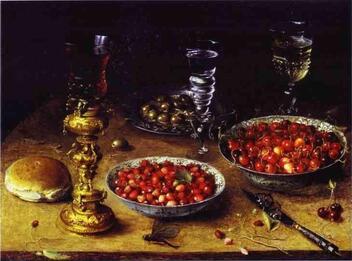
| I am enchanted by the glorious red colors, the elegant shape, the deep sweet taste and the pleasing texture of cherries. I also find the significance of cherry trees, cherry blossoms and the glorious fruit in history, folklore and art deeply satisfying. Cherries are indeed worthy of celebration. To honor the lovely month of June, I invite you, with the help of our website, to a Cherry Tea. |
This Cherry Tea in the month of June highlights fresh cherries that are readily available in the markets. Since cherries have a short growing season, be careful to time your special event accordingly. Our website also features an elegant and elaborate June Wedding Reception Tea for fifty guests with a complete Planning Guide and Grocery and Equipment Lists. This Cherry Tea is a simpler event designed for a smaller group. We think it would be perfect for a small Wedding Shower or even for a Father’s Day family gathering, as we don’t know many men who hate cherries.
We do not want to overwhelm our guests with cherries in every item we offer on the menu, so our Savory selection includes classic summer tea sandwiches that do not contain cherries. We also want to feature other summer favorite that pair beautifully with cherries -- almonds with our savory cheese selections and in the sweet Warm Cherry-Almond Tart and lemons, featured in the Lemon Curd that accompanies our Cherry Scones. And of course, we must include chocolate in our Black Forest Brownies, as chocolate and cherries are best friends.
You will need about two pounds of fresh sweet cherries to make the Cherry Orangeade, Cream Scones with Cherries, Cheese Tray and Warm Cherry Almond Tart on this menu. The Tart will require one pound of cherries; you will need about half a cup each for the beverage and the scones. For the Cheese Tray, all you have to do is scatter some fresh unpitted cherries, about half a cup, among the cheeses. You will have to pit the rest of the cherries. Cooking stores are full of cherry pitting tools and devices. I go old school by plopping down on my kitchen stool with disposable gloves on (yes, cherries will stain your fingers,) and a small paring knife in my hands. It’s not rocket science, but it will take a little time to stem and pit two pounds of cherries. I recommend Mozart to keep you company.
Beverages:
Cherry Orangeade
Sweet Cherry Flavored Tea
Savories:
European Cheese Assortment with Fresh Cherries, Almonds and Wheat Meal Biscuits
Classic Cucumber Sandwiches
Best Summer Tomato Sandwiches
Scones:
Cream Scones with Cherries
Lemon Curd and Mock Devonshire Cream
Sweets:
Black Forest Brownies
Warm Cherry-Almond Tart
Cherry Orangeade
Make this colorful and refreshing summer beverage like Mimosas, using tall iced tea glasses. Place about three pitted cherries, cut in half, in the bottom of each glass. Fill about half way with freshly squeezed orange juice. (You can use bottled juice, but fresh tastes so much better.) Top the glasses off with sparkling water or chilled champagne. Serve with a long handled iced tea spoon in each glass so guests can retrieve the cherries when they have finished drinking the Orangeade.
Sweet Cherry Flavored Tea
Cherry flavored teas are easy to find on line and in tea shops and quality grocery stores. Adagio Teas offers a Cherry Tea on line, and St. Dalfour Organic Black Cherry Tea is also easy to find on Amazon. Why not treat yourself in advance to a few selections of Cherry Flavored Teas and share your favorite with your guests?
European Cheese Assortment with Fresh Cherries, Almonds and Wheat Meal Biscuits
This elegant presentation is easy to assemble, but do not be tempted to economize on the cheeses. There is a huge difference in quality between the dreaded slices of “American” cheese and traditionally produced European style cheeses. Here we are highlighting the flavor harmonies among toasted almonds, fresh cherries and cheese. I recommend three cheese selections that would complement cherries and almonds while offering contrasting textures, colors and flavors:
Gruyere, a hard, yellow classic Swiss cheese made from the milk of dairy cattle and named for the city in Switzerland where it originated.
Brie, a pale, soft cow’s milk cheese with an edible rind named for the city in France where it originated.
Mascarpone, an Italian soft cow’s milk cream cheese, coagulated by the addition of acidic substances such as lemon juice.
Serve the cheeses at room temperature, uncut, on a wooden or marble cheese board if you have one, or on a decorative platter. Add three or four small cheese knives to the platter, and arrange the toasted whole almonds, whole cherries with stems and wheat meal biscuits (purchased at a good grocery store,) decoratively among the cheeses. Place a small ceramic bowl nearby for guests to deposit the cherry pits and stems.
Classic Cucumber Sandwiches
The recipes for Cucumber and Tomato Sandwiches, the Scones, the Lemon Curd and Mock Devonshire Cream are all available for free on this website: myteaplanner.com. Go to our Home Page, click on The Tea Book and scroll to Tea Menu Basics. At the end of this chapter, you can click on Free Recipes, where these and many other basic tea foods will be pictured. Click to download the recipes you will need for your Cherry Tea.
Best Summer Tomato Sandwiches
As with all tea sandwiches, freshness is the secret. Make the Cucumber and Tomato Sandwiches last, while the scones are baking and just before your guests arrive. Use unrefrigerated cucumbers and tomatoes and pre-softened butter. Tea sandwiches should not be refrigerated. Place the sandwiches on a decorative platter or tray; cover the tray lightly with slightly dampened paper towels or a dampened kitchen towel to prevent them from drying out until the guests arrive.
Cream Scones with Cherries
Use our recipe for Cream Scones with Berries and substitute about half a cup of pitted and quartered fresh cherries for the berries.
Lemon Curd
Lemon Curd, which will harmonize beautifully with the Cherry Scones, takes a while to make, as it needs to be cooked and cooled. You can make it the day before the tea and refrigerate it. Serve it in a small decorative container—Lemon Curd looks beautiful in a small crystal bowl or jar—with a small serving spoon.
Mock Devonshire Cream
This recipe is easy to make and can be whipped up in a few minutes. You can make it the night before or the morning of your Cherry Tea. Refrigerate both the Lemon Curd and the Devonshire Cream until you are ready to place them together on the tea table with the Scones. Include separate attractive serving spoons for the Lemon Curd and the Devonshire Cream.
- ½ cup (1 stick) unsalted butter
- 6 ounces bittersweet or semi-sweet chocolate (we used Ghirardelli’s,) divided
- 2/3 cup sugar
- 1 teaspoon vanilla extract
- 2 large eggs, at room temperature
- ½ teaspoon salt
- ½ teaspoon baking powder
- 2/3 cup flour
- ½ cup chocolate chips
- 2 Tablespoons (or more) Kirschwasser Cherry Brandy, optional
- 1 (12 ounce) jar cherry preserves (we used Bon Maman)
- 1 cup heavy whipping cream, chilled
- 2 tablespoons powdered sugar
- Cooking spray
Special equipment:
Large glass (microwaveable) mixing bowl or large glass measuring cup (1 quart or more,) hand-held electric mixer, 8-9-inch square baking pan. Rubber spatula, medium sized metal mixing bowl, cooling rack, plastic wrap, pastry bag (optional) potato peeler or hand grater, waxed paper, decorative platter
Makes: 16 brownies
Preheat oven to 350° F
- Spray the bottom of an 8” square baking pan with cooking spray. Set aside. In a large glass mixing bowl or measuring cup, melt the butter, cut into chunks, and 4 ounces of the chocolate, broken into pieces, in a microwave oven at 30-second intervals, stirring between intervals, until the mixture is smooth, and no chunks of chocolate remain. Set aside to cool slightly.
- Using a hand-held electric mixer, blend the sugar and vanilla into the chocolate mixture. Beat in the eggs one at a time. Add the salt, baking powder and flour and mix just until blended. Stir in the chocolate chips with a rubber spatula. Pour the batter into the prepared pan and bake in the preheated 350° F oven for 20-25 minutes until the center is set. Do not overbake.
- Place the brownies on a cooling rack to cool slightly. Sprinkle the surface of the brownies with kirsch, if desired. Spread the cherry preserves over the warm brownies. Cool to room temperature, cover with plastic wrap, and refrigerate for 2 hours or overnight.
- Prepare the Whipped Cream Topping: Chill the metal mixing bowl and the beaters for the electric mixer in the freezer. While the equipment chills, place a sheet of waxed paper on the counter and grate the remaining 2 ounces of chocolate, or make chocolate curls with a potato peeler. Assemble the electric mixer and beat the chilled whipped cream in the chilled bowl until slightly thickened. Add two tablespoons of powdered sugar and continue to beat until soft peaks form.
- Place the whipped cream in the refrigerator and remove the chilled brownies. Cut them into 16 small squares and place the brownie squares on a decorative platter in one layer. Remove the cream from the refrigerator and place a generous dollop of whipped cream on top of each brownie. Or use a pastry bag with a star tip to pipe a rosette of whipped cream on each brownie. Sprinkle with grated chocolate or chocolate curls. Refrigerate until ready to serve and refrigerate any leftovers.

Make this satisfying rustic summer tart the morning of your Cherry Tea, so it will be perfectly fresh. Let the tart stand at room temperature until ready to serve. It tastes best while it is still warm. I adapted this recipe from the June 2005 issue of Bon Appetit magazine. Sometimes I think that the recipes in Bon Appetit are unnecessarily complicated, and you may agree when you see the elaborate procedure for pre-baking the tart crust before even adding the filling. This process includes freezing and then double baking the crust. However, because the filling includes a small amount of custard to bind the cherries together, it is necessary to pre-bake the crust to make sure it is extra crispy before adding the custard filling to prevent a soggy crust.
When pre-baking an unfilled pie crust, it is necessary to cover it with foil and add weights, either uncooked beans, pie weights, or a disposable aluminum pie pan with a weight on top (which I used,) to prevent the crust from forming bubbles.
This recipe recommends using a straight-sided 10-inch tart pan with a removable bottom, which will produce a large, flat tart. If you don’t have this piece of equipment, you can use a shallow 9-inch pie pan, which will make your Cherry Tart look more like a Cherry Pie with no harm done. I used a straight-sided 9-inch ceramic pie/tart pan, which I happen to own. If you use a 9-inch pie or tart pan, it is not necessary to roll the crust out to make it larger.
- 1 roll of refrigerated pie crust, such as Pillsbury Pie Crusts
- 1 pound of fresh sweet cherries, pitted and left whole
- 6 tablespoons sugar
- 1 tablespoon flour
- ½ teaspoon cinnamon
- ¾ cup heavy whipping cream
- 3 large egg yolks
- 1 ½ teaspoons finely grated lemon peel
- 1 ¼ teaspoons pure almond extract
- 1 teaspoon finely grated orange peel
- 1/8 teaspoon salt
- ½ cup sliced almonds
10-inch tart pan with removable bottom, parchment paper (or a 9” shallow pie or tart pan), rolling pin, ruler, foil, dried beans or pie weights (or a 9’ disposable aluminum pie pan), spatula, large mixing bowl, whisk, wire rack, table knife, attractive round rimmed 11-12” serving platter
Makes: 8 servings
Preheat oven to: 350° F
- Place a large sheet of parchment on the counter and roll out the refrigerated pie crust to a 12-inch round. Transfer the dough to a 10” tart pan with a removable bottom and fit the crust snugly into the pan, folding the outside edges over to form a double edge (If using a 9” pan, simply fit the crust into the pan and decoratively crimp the edges). Freeze for 10 minutes.
- Line the crust with foil and fill it with dried beans or pie weights (or for a 9” pan, place a 9” disposable aluminum pie pan onto the crust and add beans or pie weights). Bake the crust in the preheated oven for about 20 minutes. Carefully remove the foil and beans (or aluminum pan) and continue baking for about 8 more minutes until the crust is golden brown. Press the crust down with a spatula if it forms bubbles. Cool completely. While the crust cools, stem and pit the cherries.
- For the filling, line the cooled crust with pitted cherries. In a large mixing bowl, whisk together the sugar, flour and cinnamon. Whisk in the cream, egg yolks, lemon peel, almond extract, orange peel and salt until well blended. Pour the cream mixture over the cherries and sprinkle the sliced almonds evenly over the top.
- Bake the tart until the center is set, about 40 minutes. Watch carefully and cover loosely with a sheet of aluminum foil if the almonds or crust appear to be browning too quickly. Cool on a wire rack for 30 minutes. Run a table knife carefully between the inner rim of the tart pan and the crust to make sure that none of the crust is sticking to the pan. Carefully remove the rim of the tart pan and transfer the tart, including the bottom section of the tart pan, to a decorative round platter and serve immediately. Refrigerate any leftovers.

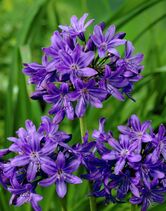


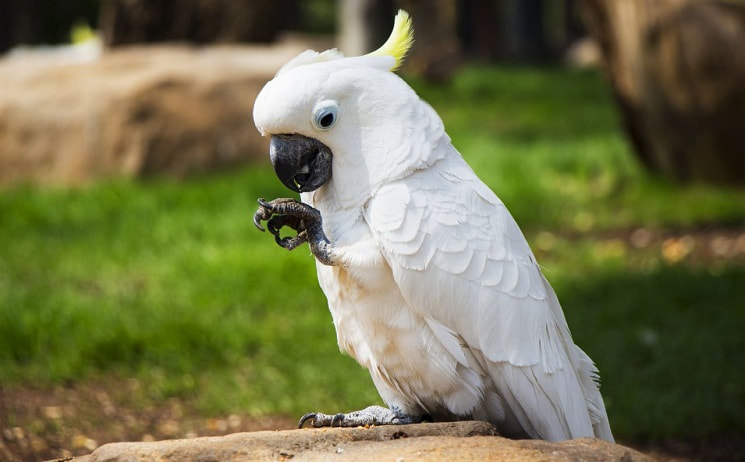




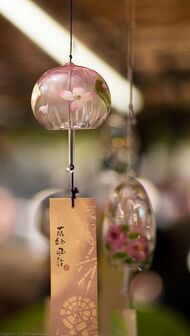

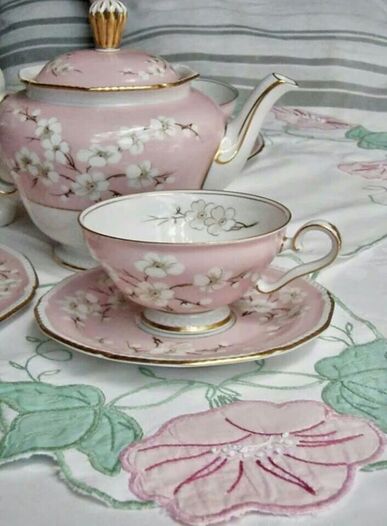
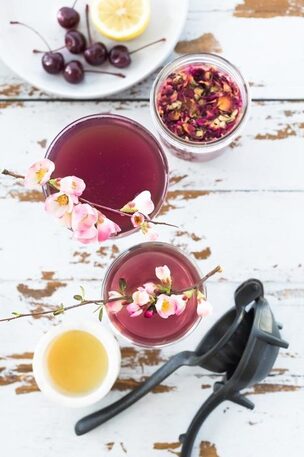

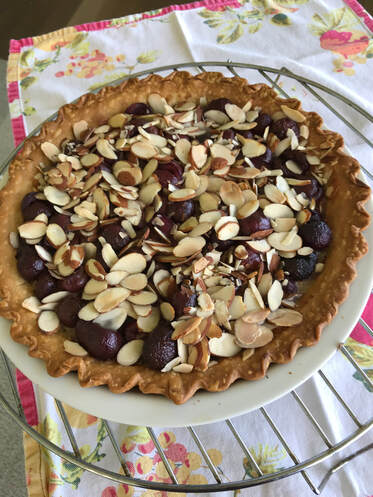
 RSS Feed
RSS Feed